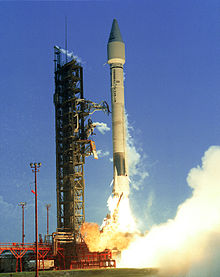
Back Атлас I Bulgarian Atlas I Czech Atlas I Galician אטלס 1 HE Atlas I ID Atlas I Italian アトラスI Japanese Atlas I Polish Atlas I Portuguese Атлас-1 Russian
 Launch of the maiden flight of the Atlas I, with the CRRES satellite | |
| Function | Expendable launch system |
|---|---|
| Manufacturer | General Dynamics |
| Country of origin | United States |
| Size | |
| Height | 43.90m (144.00 ft) |
| Diameter | 3.05m (10 ft) |
| Mass | 164,300kg (362,200 lb) |
| Stages | 2.5 |
| Capacity | |
| Payload to 185 km (115 mi) LEO | |
| Mass | 5,900 kg (13,000 lb)[1] |
| Payload to GTO | |
| Mass | 2,375 kg (5,236 lb)[2] |
| Associated rockets | |
| Family | Atlas |
| Launch history | |
| Status | Retired |
| Launch sites | LC-36B, Cape Canaveral |
| Total launches | 11 |
| Success(es) | 8 |
| Failure(s) | 3 |
| First flight | July 25, 1990 |
| Last flight | April 25, 1997 |
| Boosters – MA-5[3] | |
| No. boosters | 1 |
| Powered by | 2 LR-89-7 |
| Maximum thrust | 1,901.6 kN (427,500 lbf)[3] |
| Specific impulse | 293.4 s (2.877 km/s) |
| Burn time | 155 seconds[2] |
| Propellant | RP-1 / LOX |
| First stage | |
| Powered by | 1 LR-105-7 |
| Maximum thrust | 386.4 kN (86,900 lbf)[3] |
| Specific impulse | 316 s (3.10 km/s) |
| Burn time | 266 seconds[2] |
| Propellant | RP-1 / LOX |
| Second stage – Centaur | |
| Powered by | 2 RL-10A |
| Maximum thrust | 147 kN (33,000 lbf) |
| Specific impulse | 449 s (4.40 km/s) |
| Burn time | 410 seconds[2] |
| Propellant | LH2 / LOX |
The Atlas I was a US expendable launch system manufactured by General Dynamics in the 1990s to launch a variety of satellites. It was largely a commercial rebrand of the Atlas G (although it did fly multiple government payloads), but did feature several electrical and guidance improvements.[4] Atlas I did not feature any major payload capacity improvements over its predecessor[1] but did offer a larger payload fairing option.[2] Eleven launches took place, with three failures.
Atlas I would be further developed and improved upon to produce the highly successful Atlas II rocket.[2]
- ^ a b Gunter D. Krebs. "Atlas-1 (Atlas I)". Gunter's Space Page. Retrieved July 17, 2022.
- ^ a b c d e f General Dynamics (April 1992). "Atlas Mission Planner's Guide". Retrieved July 17, 2022.
- ^ a b c Norbert Brügge. "Variants of the "stage and a half" drive system (MA) of the Atlas rocket". Archived from the original on January 20, 2016. Retrieved July 17, 2022.
- ^ Mark Wade. "Atlas I". www.astronautix.com. Archived from the original on October 16, 2016. Retrieved August 18, 2020.